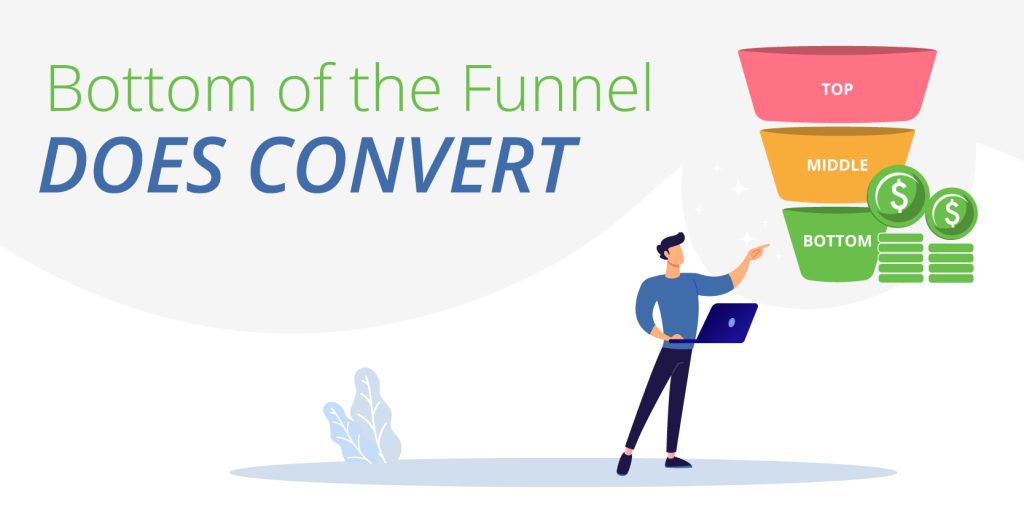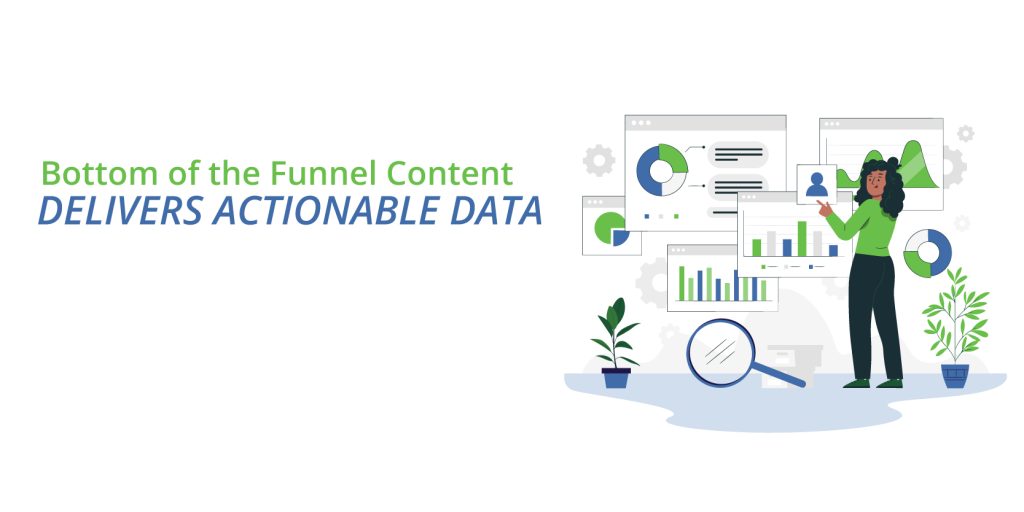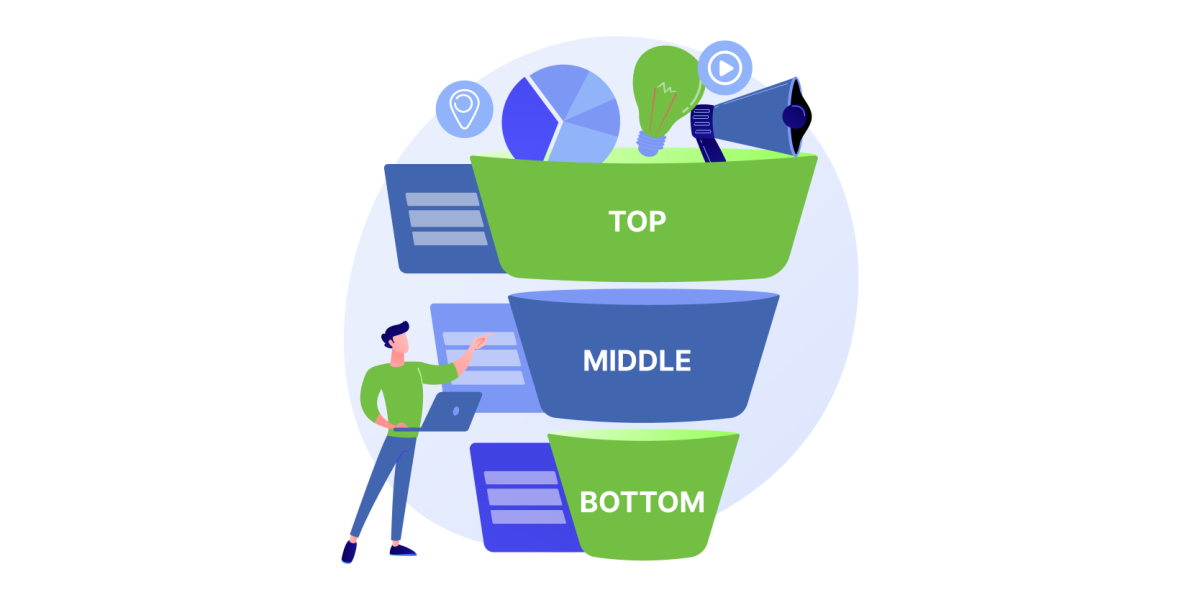Healthcare marketers tend to spend a lot of time and effort on top-of-the-funnel activities in an effort to drive market awareness and build trust with prospective patients.
That sounds like a great idea, but if you’re not doing it right, you could be wasting significant money — especially if you are running paid campaigns to drive people to your top-of-the-funnel content.
In this article, we’ll outline the most common mistakes healthcare digital marketing teams make. If you’re not doing any of these, congratulations! If you are, you need to reconsider your strategy.
First, however, let’s discuss marketing funnels and how they work.
What are Marketing Funnels?
A marketing funnel is a way to visualize the customer’s journey from the time they first become aware of your brand until they turn into customers, or in the case of healthcare, patients.
Although there are different models, you can generally break down the process into three stages:
- Top of the funnel
- Middle of the funnel
- Bottom of the funnel

Top of the Funnel
The top of the funnel (TOFU) is where people are first exposed to your organization. You’re not selling your services at this point. Instead, your focus is on providing helpful information to establish yourself as an expert and expose your practice or organization.
Common goals for TOFU content include:
- Improving website traffic
- Ranking organically for keywords
- Generating interest
- Signing up for email marketing
Middle of the Funnel
In the middle of the funnel, (MOFU) you’re taking those that have engaged with you and nurturing them to keep them connected to you. These are people that have shown an interest in what you are offering, but are not ready to make any kind of commitment. They are still researching and not going to make an appointment just yet.
Typical goals for MOFU content include:
- Education
- Keeping your healthcare organization top of mind
- Building trust
Bottom of the Funnel
When you drive potential patients through the funnel to the bottom, that’s where you get action. The goal for bottom-of-the-funnel (BOFU) content is simple: convert someone’s interest into taking action that can lead to revenue.
That’s why the bottom of the funnel is so much more important, because that’s where you close the deal and convert prospects into patients.
Healthcare Digital Marketing Mistakes
Many healthcare digital marketers make the mistake of focusing too heavily on top-of-the-funnel content. Yet, TOFU content simply doesn’t convert.
Top of the Funnel Does Not Convert
Whether you are spending money on paid TOFU campaigns or investing time and money to develop content for organic purposes, you have to remember the goal of TOFU marketing. People who come across this type of content are looking for information. They’re not ready to make a decision at this point.
In some cases, you may give them the information they need but give them no reason to connect with you further.
There are two other specific challenges with top-of-the-funnel content. The first is about the intense competition at the top of the funnel. The second is about where people get their healthcare services.
Intense Competition for TOFU Content
High authority sites and nationally recognized healthcare organizations dominate the organic ranking with large content libraries covering just about every ailment, treatment, and test protocol that’s out there. It’s exceptionally difficult to break through.
People Seek Treatment Locally
Healthcare is also mostly a localized decision. If you do manage to rank highly for TOFU content, much of the organic traffic you generate is unlikely to be in your targeted geographic region since TOFU content is almost purely educational.

For example, if you are a cardiologist presenting information about the warning signs of heart disease, the people that see that information could be from all over the world. What’s the chance they live in your community?
Bottom-of-the-funnel content can be effectively targeted locally to ensure you’re reaching the people that will book appointments and become patients.
Exhausting Ad Spend at the Top of the Funnel
Another mistake healthcare digital marketing teams make is spending the bulk of their advertising budget on TOFU content.
For healthcare, TOFU content has a role, but it can be terribly ineffective. On average, as many as 45% of leads generated by top-of-funnel content never go anywhere. In other words, half of the money you spend on TOFU content is wasted. That doesn’t include any other potential patient leads you do attract, many of which will never materialize.

People that are in the active disease stage account for the overwhelming amount of billing in healthcare. These are not people beginning their search for information about a disease but are actively trying to manage it, looking for help, or needing treatment. These are the people at the bottom of the funnel that are in-market for a healthcare provider now.
Also, about half of the US population has a chronic disease, accounting for 86% of all healthcare spending. These are also people at the bottom of the funnel, who may be looking for alternatives to their current healthcare.
When you focus on spending at the bottom of the funnel, you are reaching people that want solutions and not just information. While top-of-funnel content strategies do generate leads, only 7% of salespeople say the leads they get from marketing are high-quality leads that produce conversions or customers.
Falsely Categorizing Bad Marketing as Branding
A lot of bad marketing gets written off as branding. Even if it never converts, it helps “build the brand.”
At the same time, measuring brand awareness can be challenging and ambiguous. Plus, while it’s nice to be recognized as the top brand or provider in a field, it’s much better to have a profitable healthcare business that meets patients’ needs.
In healthcare digital marketing, immediacy and urgency are far more important than brand awareness. It’s better to focus your efforts at the bottom of the funnel and focus efforts on converting the keywords that match searcher intent for both paid and organic campaigns.
Healthcare marketers that do not quickly adjust to focus on conversions over brand awareness will likely see market share erode and slower patient growth. Much more important than potential patients being aware of your brand is for your ads to appear at the moment that they are searching for the service that you provide.
Hoping that a patient remembers your brand at that moment that they are searching for a solution is a failed, antiquated strategy that is no longer effective. Those that adjust will reap major benefits.
Bottom of the Funnel Does Convert
Bottom-of-the-funnel content is designed to convert, and that’s what it does. When people are in the market for any product or service and you can give them the information they need to make a decision and provide them with a reason to choose you, it leads to quick wins.

Let’s say you are one of the 25% of Americans that don’t have a primary care physician and you need medical attention. Alternatively, you might not have access to your PCP due to limited hours or appointment availability.
What are you likely to do? Most people will turn to Google and look for a healthcare provider that is available and provides the services or treatments they need. These are patients that have already reached the bottom of the marketing funnel and are ready to make a decision about where they get their healthcare.
If you’re not spending your marketing dollars on attracting BOFU prospects, you’re missing a significant opportunity to attract in-market customers.
Bottom-of-the-funnel Content Delivers Actionable Data
John Wanamaker was considered a pioneer in marketing and coined the phrase:
“Half the money I spend on advertising is waste. The trouble is I don’t know which half.”
Wanamaker said that back in the late 1900s at a time when consumers didn’t face the bombardment of marketing messages they do today. If you only knew the answer to where your marketing dollars were working successfully, you could get a much better ROI.
One of healthcare marketers’ top concerns is tracking the return on investment. 21% of all marketers surveyed said identifying ROI for marketing spend is their top challenge. Within all of the activities they do, which are the ones that are delivering the best results?
Healthcare digital marketing allows you to do that. Because we can draw a line directly from engagement with a PPC or organic campaign to patient inquiries and then to appointments, we can see what ads and content provide the best return and what we’ve learned is that the most profitable spending is at the bottom of the funnel.
While the top of the funnel is often a guessing game to figure out what happens, the bottom of the funnel can provide you with more direct data about what’s working. This data can help inform your approach at every stage of the funnel.

Applying the lessons you learn from tracking BOFU content performance, you can weave the right message at every stage of the funnel. This helps optimize your content and performance. It makes everything work together more efficiently and can reduce your overall patient acquisition costs.
Avoiding Healthcare Digital Marketing Mistakes
None of this is to say you shouldn’t invest the right amount of resources in each stage of the marketing funnel. There’s a value in every stage.
However, investing too heavily in the top of the funnel at the expense of the bottom funnel is a costly mistake. Your spending will be focused on information-seekers rather than those that need the healthcare services you provide. You may be able to build your brand, but it’s the bottom-of-the-funnel content that builds your bottom line and keeps your business healthy and sustainable.
Daymark Interactive is a data-driven digital marketing agency that specializes in helping healthcare organizations to acquire more patients. Our proprietary closed-loop strategy helps healthcare digital marketing teams avoid these common mistakes and acquire more patients.
Our core services include:
- PPC Marketing
- Conversion-focused landing page design and optimization
- Reputation monitoring and management
By optimizing your healthcare digital marketing and spending your efforts in the right places, you can create a better patient experience from start to finish.
Contact Daymark Interactive today and dominate your competition.
Looking for more insights into attracting more patients? Read our in-depth report, Healthcare PPC: 6 Expert Tips for New Patient Acquisition.

